Recently I saw a Basic Instructions comic in which the author/protagonist, Scott, weighs up his
shaving options. You can read the full comic here, assuming you don’t read
Basic Instructions already (and you should).
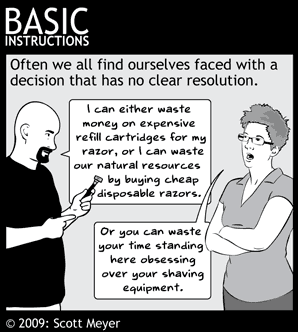
As the folks leaving comments on that comic quite
rightly note, the comic covers only two of a number of different solutions to shaving: disposable razors, and cartridge razors, neglecting at least three other alternatives (even if you
don’t count “just let it grow” as an option). Thanks in part of many of these comments, he’s now going to experiment with a few different options.
I’ve tried more different approaches than most gents, I suspect, so I thought I’d share with you a brief history of my shaving experience:
Electric Shaver
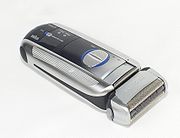
Surely I can’t be the only person who’s found these to be quite so useless as they appear. I’ve owned two in my time: a basic one that my dad gave me during my teen years in lieu of the
iconic father-son bonding experience that I’m lead to believe that many other boys found in learning to shave from their dads; and a second, more-fancy one given to me in a gift box
which also contained other male grooming tools (some of which are actually really quite useful: it’s just a pity that the shaver itself isn’t up to much).
I don’t hear anybody else complaining, so I’m probably in a minority: perhaps it’s the the softness of my skin… or the prickliness of my hair… or maybe I’m just “doing it wrong.” The
net result is much the same: if I use an electric shaver it cuts my facial hair down just enough to still be slightly stubbly, it’s near-impossible to make a good effort of the area
under my jaw, and there isn’t the control to be able to work around the outlines of a partial beard, as I have nowadays. Perhaps worse yet, it always feels like they “pluck” almost as
much as they “cut”. The first few times I used one I took it apart to try to work out if I’d perhaps missed a crucial set-up step, like pulling out some kind of secret pin that actually
engaged the razor blades. I hadn’t.
Disposable Razors

So I ended up using disposable razors. They’re cheap and simple and they work, right? They’re not the easiest things in the world, with their flimsy little plasticky handles and their
strange shape… Although there is the fact that they’re not actually very sharp.
You know how they say that you’re more likely to cut yourself with a blunt blade than a sharp one, because of the increased pressure you have to use? Well there’s a limit to that logic,
and the limit is when the blade is so dull that you’d be hard-pressed to cut yourself if you were trying. I don’t know if it’s an anti-suicide measure by the Bic company, but
wow are their blades ineffective. Sometimes you feel like you’d be better using the edge of the shitty plastic handle than the metal blade edge.
Cartridge Safety Razor
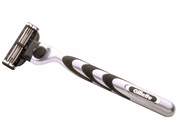
One day, back in in my first year at University, an unexpected parcel arrived for me. It turned out to be from Gillette, and contained a Gillette Mach3 (which had been launched a year-and-a-bit earlier). Their thinking, of course, was that as they’d given me a free razor
I’d use it and then continue to buy the blades. “The fools,” I thought, “I’m perfectly happy with my twice-a-week-if-I-can-be-bothered shaves with these throwaway plasic things!” I
planned to use the new razor ’til I’d blunted (all three of) it’s blades, then I’d just throw it away. No problem.
It turns out that giving away free razors like this might have been one of the smartest marketing promotions that Gillette has ever done, because, for me at least, it worked. A
three-blade cartridge razor is a fabulous way to shave, and it’s a huge improvement on disposables. I’m sure that over the nine years or so I used my Mach3 – even if you don’t count the
extra one I bought when I lost one – Gillette more-than made their money back in all of the cartridges I bought.
It’s got a proper handle with grips that work even when it’s wet, a funky button-release to let go of spent cartridges (and for me, at least, the blades would last a reasonable amount
of time, presumably aided by the fact that the work was shared amongst three cutting surfaces), it tilts gently to work around hard-to-reach spots… it’s just a really well-designed bit
of technology.
Traditional “Double-Edged” Safety Razor
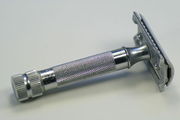
Back in the early years of the 20th century, the
removable-blade safety razor appeared to fill the demand for a razor that was easier than straight razors, which required such care and attention to both use and maintenance that many men just said “fuck it” and went to the
barber’s instead. For decades, the double-edged razor was king, until it started to give way in the 1970s to cartridge razors and electric shavers. There are two major reasons for this
change: firstly, cartridge razors are easier to use than double-edged razors – you can use them even if you’re tired, or drunk, or stupid. Secondly, cartridge razors (and, to a lesser
extent, except approaching Christmas, electric shavers) have been very heavily marketed for years and years: this makes sense from the perspective of the manufacturer, because of the
principle of vendor lock-in. Vendor lock-in, more often discussed in the context
of electronic goods and computer software, is about forcing the users of your product to continue to use your product: to remove from them the freedom to go elsewhere. It’s particularly
obvious in the marketplace of cartridge razors, because each manufacturer can manufacture blade cartridges which fit only it’s own products. An entire marketing strategy, the razor-and-blades business model, is named after
this approach.
At the tail end of this hundred-year history of razors is now, 2009. I’ve gotten good use out of my Mach3, but there are a few things over the last year or so that have really put me
off continuing to use it:
- Actual good-old Mach3 blades became harder and harder to find as the manufacturer began to focus production on Mach3 Turbo and M3Power cartridges, both of which cost more.
- Mach3 Turbo is basically the same thing as Mach3, only a little more expensive for the privilege of “anti-friction blades”, which seems like a marketing gimmick – I certainly can’t
tell the difference, and if there’s anything to learn from this blog post it’s that I’m reasonably picky
- M3Power blades are identical to Mach3 Turbo, only more expensive still(!). What do you get for your money is “even more lubrication” (yeah, right) and blades that are compatible
with the micropulse (i.e. vibrating) feature of the M3Power handle, which virtually everybody says is a scam.
- Seriously, the marketing is bullshit. It was proven in court.
- As the Onion predicted back in 2004, we’re starting to see the
first five-blade razors getting serious marketing treatment: the “Gillette Fusion Power Stealth” (presumably targeted at men who like awesome-sounding buzzwords: seriously,
what do any of those words have to do with removing hair?) have five blades and a sixth “precision trimmer”. That’s six blades every time you buy a cartridge: how much does
that cost? I don’t even want to know. And someday, they’ll stop selling Mach3 blades entirely and they’ll try to force me to switch to an even more profitable razor, probably
with seven blades and a lubricating, vibrating strip that sings the blues.
-
Gillette’s razor blades are sold at 4750% profit. Four
fucking thousand seven fucking hundred and fifty fucking per cent. That’s like me going to Sainsburys and buying a loaf of bread (85p), a small pack of margarine (44p), and a
medium-sized pack of cooked ham (£1.64), making ten ham sandwiches, and then selling them for £14 each. For a ham sandwich. £14.
So, a month and a bit ago, I decided to escape from this trap, and go open-source with an old-school double-edged razor.
Going Open Source
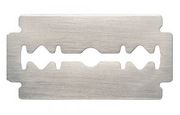
Sick of the marketing nonsense and the overinflated (and rising) costs of cartridges, I bought myself a traditional style safety razor (it looks a lot like the one in the photo in the
last section), brush, soap, and a sackload of blades: and wow, blades are cheap.
It turns out that learning to use a double-edged safety razor is just a little bit like learning to shave all over again, with plenty of opportunity for self-injury along the way:
although it doesn’t take so long – despite managing to clip myself the first few times I used it (nothing that a quick application of titanium dioxide couldn’t fix, albeit in an ouchy-ouchy way). It also takes quite a bit longer than shaving with a cartridge
razor: rather than the eight minutes or so I’d spend shaving with my Mach3, I spend about 18 minutes in the bathroom with my double-edged safety razor. That’s not the end of the world,
because I only bother to shave about one day in three anyway, and adding ten minutes to the time it takes to do something so infrequent isn’t going to kill me.
It’s actually remarkably good for the extra time it takes, though: I’m suddenly all remarkably-smooth, having shaved with this scary-looking implement: better than I’d ever managed with
a cartridge or with a disposable, and far, far better than I ever got out of an electric.
So: cheap as chips to get blades for, and a better shave, at the expense of taking longer to actually have a shave. It’s a good deal in my book, and I’d recommend giving it a try,
gents, if you haven’t already. Plus, you get the same kind of fuzzy feeling you get from using Linux or OpenOffice.org because it’s just a little bit more like using something that’s
genuinely free of vendor lock-in.
Plus, it looks cool.
(I’m considering trying a proper straight razor at some point – or, more likely, one which takes snapped razor-blades in an injector, because I don’t particularly feel like
having to learn how to sharpen and hone a true razor – anybody got any experience of them?)





